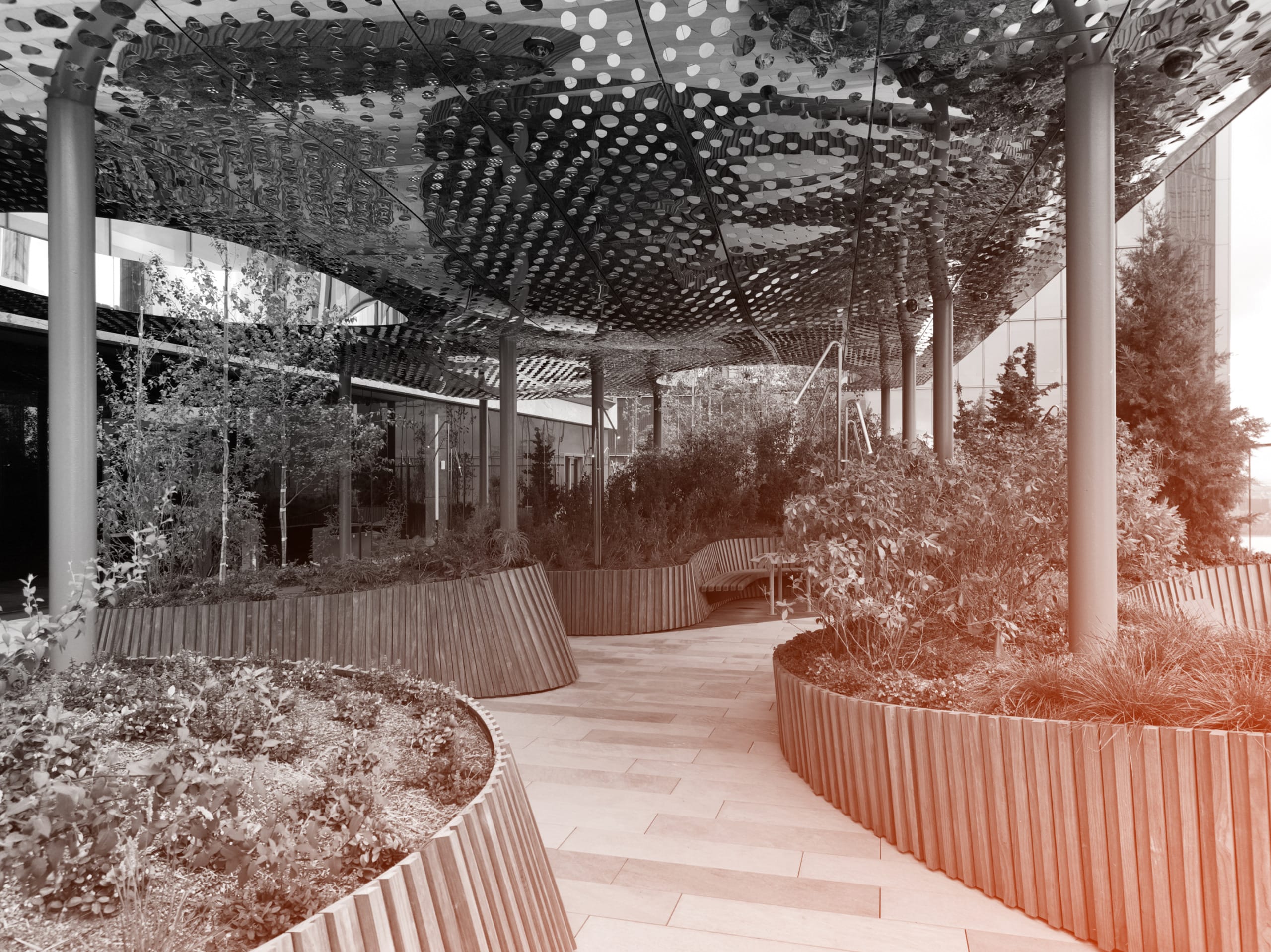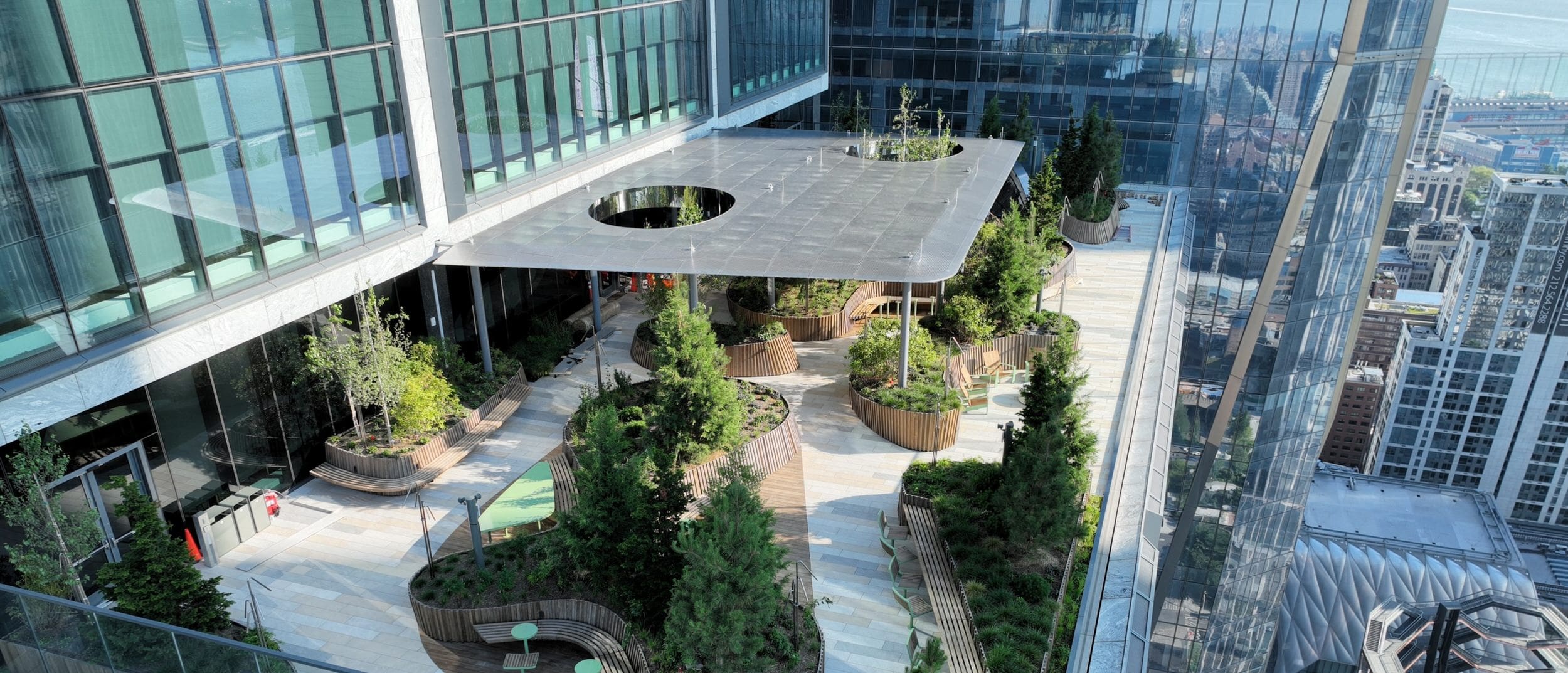Pearl Marriott
Pearl District Marriott Residence Inn
The Pearl District Marriott Residence Inn, designed by SERA Architects, is a project featuring a bumped and perforated screenwall supplied by Zahner. Named for its neighborhood, the Pearl District is a historic area of Portland. Local businesses liken the urban district’s buildings to oysters, whose hidden ‘pearls’ were the gallery and artists’ spaces contained within — hence the name.
The Pearl District Residence Inn boasts 223 guestrooms in its six story building. A series of custom perforated aluminum panels by Zahner provide privacy screens for the rooms and decorative shading along the front of the façade. These painted yellow screens also add an element of modernity to the surrounding historic warehouse structures, elevating the extended stay hotel from the typical guest experience.
Parametrically Designed Perforation and Embossing
When SERA Architects approached Zahner with their idea for the perforation pattern, it existed as a simple jpeg image of an evanescent starburst shape. Zahner’s team of design engineers used that image to create an algorithmic concept that mathematically defined each perforation. The process uses a customized ImageWall system to perforate imagery on the metal surface, and create subtle variation the building’s screen wall.

Pearl District Residence Inn Marriott in Portland, Oregon.
PHOTO © A. ZAHNER COMPANY.
During the design phase, there was active communication between Zahner and SERA Architects regarding parameters and variables. This exchange of ideas was essential to reach the final design. In order to make the gradation blend in a more nuanced, subtle manner, dithering was applied during the engineering process. Zahner also worked with the designers to create a series of embossed and debossed bumps, which added texture as well as rigidity to the panels. This additional rigidity means that the metal could be specified at a thinner gauge, reducing the material cost for the client.
During this design engineering process, files were exchanged between Zahner and the architects, along with several different iterations of samples. Once the final design was determined, the files went from design engineering into production engineering.

Pearl District Residence Inn Marriott in Portland, Oregon.
PHOTO © A. ZAHNER COMPANY.

Pearl District Residence Inn Marriott in Portland, Oregon.
PHOTO © A. ZAHNER COMPANY.

PEARL DISTRICT RESIDENCE INN MARRIOTT IN PORTLAND, OREGON.
PHOTO © BEN COFFMAN.
Efficient Installation of Custom Perf Panels
The architects wanted to create seamless connection details with no visible fasteners and clean edges. The system used to achieve this is the Inverted Seam, a patented system developed for this purpose. In addition to the wall panels, Zahner provided vertical aluminum extrusions which provide the support structure. These vertical extrusions have slots so that the aluminum panels lower in and lock into place without any need for additional fasteners. This is a Drop & Lock connection.
Zahner’s locking panels require no additional hardware or attachment methods, making for a straightforward install and no visible fasteners. Each panel was also labeled with a unique code, corresponding to its location on the building. This streamlined process enabled the local installers to position and fasten the panels with ease, reducing the schedule for the client.

Pearl District Residence Inn Marriott in Portland, Oregon.
PHOTO © A. ZAHNER COMPANY.

Pearl District Residence Inn Marriott in Portland, Oregon.
PHOTO © A. ZAHNER COMPANY.

Pearl District Residence Inn Marriott in Portland, Oregon.
PHOTO © A. ZAHNER COMPANY.

Pearl District Residence Inn Marriott in Portland, Oregon.
PHOTO © A. ZAHNER COMPANY.

Pearl District Residence Inn Marriott in Portland, Oregon.
PHOTO © A. ZAHNER COMPANY.

Pearl District Residence Inn Marriott in Portland, Oregon.
PHOTO © A. ZAHNER COMPANY.

Pearl District Residence Inn Marriott in Portland, Oregon.
PHOTO © A. ZAHNER COMPANY.

Pearl District Residence Inn Marriott in Portland, Oregon.
PHOTO © BEN COFFMAN.
.

Pearl District Residence Inn Marriott in Portland, Oregon.
PHOTO © BEN COFFMAN.
.

Pearl District Residence Inn Marriott in Portland, Oregon.
PHOTO © BEN COFFMAN.
.

Pearl District Residence Inn Marriott in Portland, Oregon.
PHOTO © BEN COFFMAN.
.

Pearl District Residence Inn Marriott in Portland, Oregon.
PHOTO © BEN COFFMAN.
.






 PHOTO ©️ Parrish Ruiz de Velasco (parrch.com)
PHOTO ©️ Parrish Ruiz de Velasco (parrch.com)



 © Fedora Hat Photography
© Fedora Hat Photography Photo by Andre Sigur | ARKO
Photo by Andre Sigur | ARKO





 Ɱ, Creative Commons Attribution-Share Alike 4.0 International license, edited.
Ɱ, Creative Commons Attribution-Share Alike 4.0 International license, edited.

 PHOTO © A. ZAHNER COMPANY.
PHOTO © A. ZAHNER COMPANY.